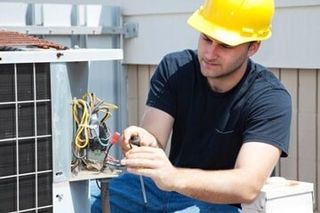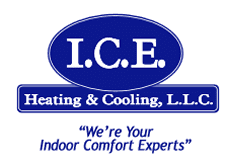Maintenance Info

Our goal is to provide you with Superior and Cost Effective Services, to ensure your system(s) is working properly and efficiently.
We recommend routine maintenance developed to increase the efficiency, reliability and life expectancy of your HVAC equipment for our residential and commercial customers.
Here at ICE Heating and Cooling, LLC, our Preventative Maintenance Plan includes an all-points evaluation to check for proper operation and look for signs of component wear and failure. We do this for any age, make or model of system, so your heating and cooling system operates at peak performance. Below is an outline of what we do.
We recommend routine maintenance developed to increase the efficiency, reliability and life expectancy of your HVAC equipment for our residential and commercial customers.
Here at ICE Heating and Cooling, LLC, our Preventative Maintenance Plan includes an all-points evaluation to check for proper operation and look for signs of component wear and failure. We do this for any age, make or model of system, so your heating and cooling system operates at peak performance. Below is an outline of what we do.
1. Replace filters (every 1 to 6 months)
Filters capture dust, dirt and other airborne contaminants and prevent them from being spread through-out the building. Keeping them clean also assures the air handling portion of the system is operating at its peak. Dirty filters can decrease cooling and heating output of the system as well as increase energy used by the system. Depending on how the HVAC system is being used, the type of facility it is installed in, etc. filters should be inspected monthly (at a minimum) and possibly replaced monthly as well. A good quality filter (a minimum of a MERV 8) should be installed at least quarterly in many systems (actual replacement time frames may vary depending on a number of factors).
2. Clean Evaporator and Condenser Coils (1 to 2 times per year)
Evaporator coils, during cooling season, are damp and wet, and provide an excellent place for molds and bacteria to grow. If coils are cleaned regularly then mold and bacteria growth can be minimized. As an additional measure we would recommend installing UVC lamps, on the discharge side of the coil, to keep them clean and prevent mold and bacteria growth all year round. Condenser coils are exposed to unfiltered outdoor air and can see considerable perform reductions due to dirt, leaves, grass, etc. which are sucked into them during normal operation. Keeping these coils clean helps keep the systems efficiency at its maximum and improves the longevity of the system.
3. Inspect areas around air intakes (2 times a year)
These are places where water, mold, bacteria, and other airborne contaminants can be drawn into the building. It is important to visually inspect and clean these areas if necessary to insure proper indoor air quality all year long.
4. Inspect the fan wheel, bearings and fan motor belts (2 times per year)
Fan assemblies should be inspected and cleaned if necessary at least twice a year. Improper airflow, as a result of dirty or improper rotation can result in increased energy costs and poor occupant comfort. Belts also need to be inspected, tightened—if necessary or changed to insure proper operation of the air delivery system.
5. Inspect all electrical devices including compressors, relays, contactors and thermostats Proper voltages and connections can greatly minimize failures and improve efficiencies.
6. Inspect and clear condensate drain lines and safety pans
Commercial air conditioners can make gallons of water per hour on the hottest of days. Clear and properly installed drains will reduce the risk of water damage.
Filters capture dust, dirt and other airborne contaminants and prevent them from being spread through-out the building. Keeping them clean also assures the air handling portion of the system is operating at its peak. Dirty filters can decrease cooling and heating output of the system as well as increase energy used by the system. Depending on how the HVAC system is being used, the type of facility it is installed in, etc. filters should be inspected monthly (at a minimum) and possibly replaced monthly as well. A good quality filter (a minimum of a MERV 8) should be installed at least quarterly in many systems (actual replacement time frames may vary depending on a number of factors).
2. Clean Evaporator and Condenser Coils (1 to 2 times per year)
Evaporator coils, during cooling season, are damp and wet, and provide an excellent place for molds and bacteria to grow. If coils are cleaned regularly then mold and bacteria growth can be minimized. As an additional measure we would recommend installing UVC lamps, on the discharge side of the coil, to keep them clean and prevent mold and bacteria growth all year round. Condenser coils are exposed to unfiltered outdoor air and can see considerable perform reductions due to dirt, leaves, grass, etc. which are sucked into them during normal operation. Keeping these coils clean helps keep the systems efficiency at its maximum and improves the longevity of the system.
3. Inspect areas around air intakes (2 times a year)
These are places where water, mold, bacteria, and other airborne contaminants can be drawn into the building. It is important to visually inspect and clean these areas if necessary to insure proper indoor air quality all year long.
4. Inspect the fan wheel, bearings and fan motor belts (2 times per year)
Fan assemblies should be inspected and cleaned if necessary at least twice a year. Improper airflow, as a result of dirty or improper rotation can result in increased energy costs and poor occupant comfort. Belts also need to be inspected, tightened—if necessary or changed to insure proper operation of the air delivery system.
5. Inspect all electrical devices including compressors, relays, contactors and thermostats Proper voltages and connections can greatly minimize failures and improve efficiencies.
6. Inspect and clear condensate drain lines and safety pans
Commercial air conditioners can make gallons of water per hour on the hottest of days. Clear and properly installed drains will reduce the risk of water damage.
Maintenance Info

Our goal is to provide you with Superior and Cost Effective Services, to ensure your system(s) is working properly and efficiently.
We recommend routine maintenance developed to increase the efficiency, reliability and life expectancy of your HVAC equipment for our residential and commercial customers.
We recommend routine maintenance developed to increase the efficiency, reliability and life expectancy of your HVAC equipment for our residential and commercial customers.
Here at ICE Heating and Cooling, LLC, our Preventative Maintenance Plan includes an all-points evaluation to check for proper operation and look for signs of component wear and failure. We do this for any age, make or model of system, so your heating and cooling system operates at peak performance. Below is an outline of what we do.
1. Replace filters (every 1 to 6 months)
Filters capture dust, dirt and other airborne contaminants and prevent them from being spread through-out the building. Keeping them clean also assures the air handling portion of the system is operating at its peak. Dirty filters can decrease cooling and heating output of the system as well as increase energy used by the system. Depending on how the HVAC system is being used, the type of facility it is installed in, etc. filters should be inspected monthly (at a minimum) and possibly replaced monthly as well. A good quality filter (a minimum of a MERV 8) should be installed at least quarterly in many systems (actual replacement time frames may vary depending on a number of factors).
2. Clean Evaporator and Condenser Coils (1 to 2 times per year)
Evaporator coils, during cooling season, are damp and wet, and provide an excellent place for molds and bacteria to grow. If coils are cleaned regularly then mold and bacteria growth can be minimized. As an additional measure we would recommend installing UVC lamps, on the discharge side of the coil, to keep them clean and prevent mold and bacteria growth all year round. Condenser coils are exposed to unfiltered outdoor air and can see considerable perform reductions due to dirt, leaves, grass, etc. which are sucked into them during normal operation. Keeping these coils clean helps keep the systems efficiency at its maximum and improves the longevity of the system.
3. Inspect areas around air intakes (2 times a year)
These are places where water, mold, bacteria, and other airborne contaminants can be drawn into the building. It is important to visually inspect and clean these areas if necessary to insure proper indoor air quality all year long.
4. Inspect the fan wheel, bearings and fan motor belts (2 times per year)
Fan assemblies should be inspected and cleaned if necessary at least twice a year. Improper airflow, as a result of dirty or improper rotation can result in increased energy costs and poor occupant comfort. Belts also need to be inspected, tightened—if necessary or changed to insure proper operation of the air delivery system.
5. Inspect all electrical devices including compressors, relays, contactors and thermostats Proper voltages and connections can greatly minimize failures and improve efficiencies.
6. Inspect and clear condensate drain lines and safety pans
Commercial air conditioners can make gallons of water per hour on the hottest of days. Clear and properly installed drains will reduce the risk of water damage.
Filters capture dust, dirt and other airborne contaminants and prevent them from being spread through-out the building. Keeping them clean also assures the air handling portion of the system is operating at its peak. Dirty filters can decrease cooling and heating output of the system as well as increase energy used by the system. Depending on how the HVAC system is being used, the type of facility it is installed in, etc. filters should be inspected monthly (at a minimum) and possibly replaced monthly as well. A good quality filter (a minimum of a MERV 8) should be installed at least quarterly in many systems (actual replacement time frames may vary depending on a number of factors).
2. Clean Evaporator and Condenser Coils (1 to 2 times per year)
Evaporator coils, during cooling season, are damp and wet, and provide an excellent place for molds and bacteria to grow. If coils are cleaned regularly then mold and bacteria growth can be minimized. As an additional measure we would recommend installing UVC lamps, on the discharge side of the coil, to keep them clean and prevent mold and bacteria growth all year round. Condenser coils are exposed to unfiltered outdoor air and can see considerable perform reductions due to dirt, leaves, grass, etc. which are sucked into them during normal operation. Keeping these coils clean helps keep the systems efficiency at its maximum and improves the longevity of the system.
3. Inspect areas around air intakes (2 times a year)
These are places where water, mold, bacteria, and other airborne contaminants can be drawn into the building. It is important to visually inspect and clean these areas if necessary to insure proper indoor air quality all year long.
4. Inspect the fan wheel, bearings and fan motor belts (2 times per year)
Fan assemblies should be inspected and cleaned if necessary at least twice a year. Improper airflow, as a result of dirty or improper rotation can result in increased energy costs and poor occupant comfort. Belts also need to be inspected, tightened—if necessary or changed to insure proper operation of the air delivery system.
5. Inspect all electrical devices including compressors, relays, contactors and thermostats Proper voltages and connections can greatly minimize failures and improve efficiencies.
6. Inspect and clear condensate drain lines and safety pans
Commercial air conditioners can make gallons of water per hour on the hottest of days. Clear and properly installed drains will reduce the risk of water damage.




